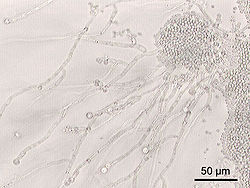Candida
genus of fungi From Wikipedia, the free encyclopedia
Remove ads
Candida is a genus or grouping of yeasts. Yeasts are a type of fungus. This group of fungi are the most common cause of fungus infections in the world.[1] Most people have or are exposed to this group of fungus but are not sick. If a person is weak because of another illness, this fungus can cause disease.[2] Candida albicans is the most common kind of Candida. Infection with this fungus is called candidiasis or thrush. Other species in this group can be found in the human gut.[3]
People can get a blood infection from this fungus.[4]
Medicines called antibiotics do not cure yeast infections. In fact, an antibiotic can make a Candida infection worse.[5] Women can get a Candida infection in their vagina. Men can also get a Candida infection in their genital area. If a person takes antibiotics for a long time, they have a greater chance of having a Candida infection. People with diabetes or HIV are more likely to get a yeast infection.[6][7]
Remove ads
Role as a pathogen
This fungus can be grown in a lab. Candida looks like large, round, white or cream circles that smell like bread.[8] Candida can be found on almost all healthy skin.[9] Dry skin has less fungus.[10] Small numbers of this fungus are found in other areas of the body. These are the nose, throat and lungs; the digestive system and the vagina. This is normal.
When this fungus causes disease in the mouth it is called thrush (oropharyngeal candidiasis). When this fungus causes disease in the female reproductive organs it is called vaginal candidiasis or just 'yeast infection'. Thrush is common in people who wear dentures.[11]
Remove ads
Treatment
In people without other illness, a candida infection can be cured with skin ointment or medicine that can be swallowed.[12] Skin medications can be bought over-the-counter without a doctor's prescription. In people who are already sick, candidiasis can become a very serious illness. It can cause abscess, thrombophlebitis, heart infection (endocarditis. It can cause infections of the eyes or other organs.[4][9] Candida infection can get into the body through cuts in the skin.[10]
Remove ads
Species
Other medically important Candida species are C. parapsilosis, C. tropicalis, and C. dubliniensis.[4]
- C. albicans
- C. ascalaphidarum
- C. amphixiae
- C. antarctica
- C. argentea
- C. atlantica
- C. atmosphaerica
- C. auris
- C. blattae
- C. bracarensis
- C. bromeliacearum
- C. carpophila
- C. carvajalis[13]
- C. cerambycidarum
- C. chauliodes
- C. corydali
- C. dosseyi
- C. dubliniensis
- C. ergatensis
- C. fructus
- C. glabrata
- C. fermentati
- C. guilliermondii
- C. haemulonii
- C. humilis
- C. insectamens
- C. insectorum
- C. intermedia
- C. jeffresii
- C. kefyr
- C. keroseneae
- C. krusei
- C. lusitaniae
- C. lyxosophila
- C. maltosa
- C. marina
- C. membranifaciens
- C. mogii
- C. oleophila
- C. oregonensis
- C. parapsilosis
- C. quercitrusa
- C. rhizophoriensis
- C. rugosa
- C. sake
- C. sharkiensis
- C. shehatea
- C. temnochilae
- C. tenuis
- C. theae[14]
- C. tolerans
- C. tropicalis
- C. tsuchiyae
- C. sinolaborantium
- C. sojae
- C. subhashii
- C. viswanathii
- C. utilis
- C. ubatubensis
- C. zemplinina
References
Other websites
Wikiwand - on
Seamless Wikipedia browsing. On steroids.
Remove ads

